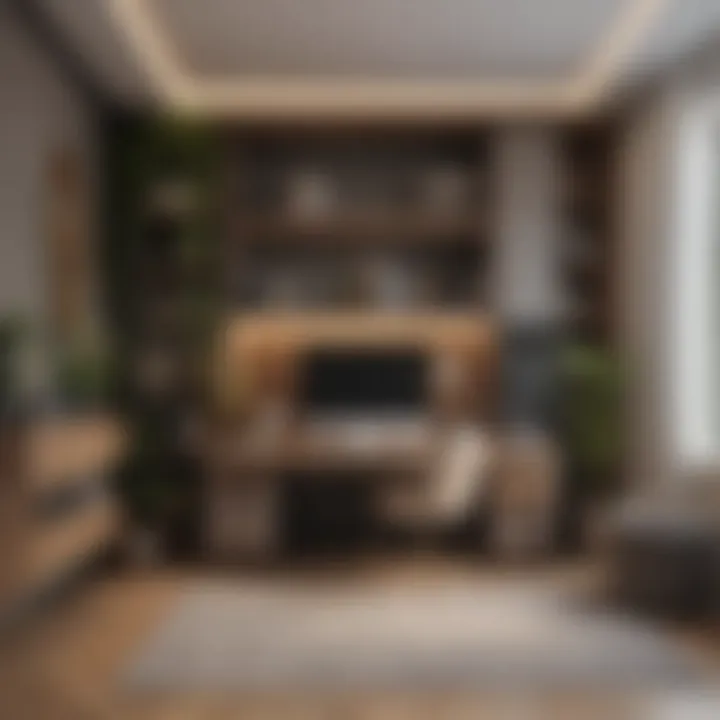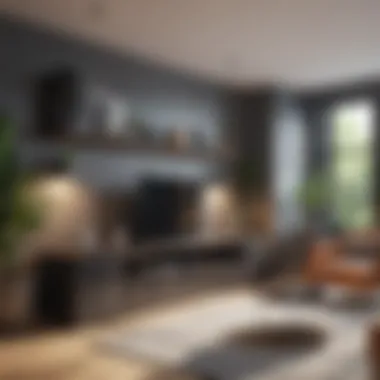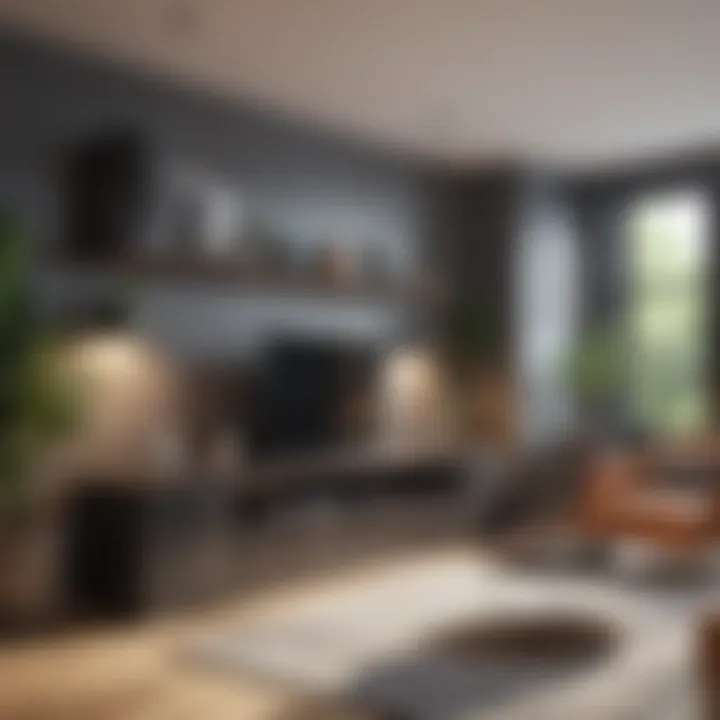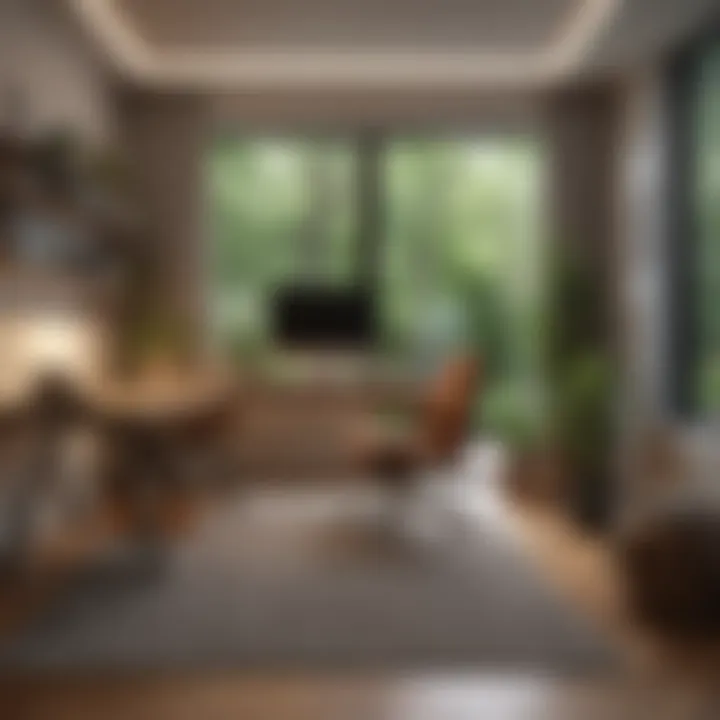Designing a Stylish Home Office-Bedroom Integration


Intro
Creating a home office that functions well, while being integrated into a bedroom, presents unique challenges but also offers numerous advantages. This design approach caters to the modern need for multi-functional spaces, where work and rest coalesce. Homeowners often find themselves balancing aesthetics with the pragmatic requirements of productivity.
In this article, we will explore various aspects of designing a home office within a bedroom. We will discuss layout considerations, essential design elements, and innovative storage solutions. Each section will provide actionable insights that can be applied by both renters and homeowners looking to maximize their living space effectively.
Design Inspiration
Design choices can significantly influence the feel and functionality of a space. Understanding current interior design trends and selecting appropriate color palettes are crucial steps.
Current Interior Design Trends
Today, minimalism continues to dominate, promoting simplicity and functionality. Clean lines and an uncluttered aesthetic enable both areas of the room to flow seamlessly. Incorporating natural materials like wood and stone fosters a calming atmosphere, which is essential for both relaxation and concentration.
Incorporating technology is also a current trend. Smart desks, integrated charging stations, and ergonomic chairs improve comfort while enhancing productivity. Open shelving can blend style with function through the display of books or decorative items.
Color Palettes and Their Effects
The color scheme of the room plays a vital role in mood and productivity. Soft, neutral tones like whites, beiges, or greys create a soothing backdrop. They can promote tranquility and focus, necessary for a productive workspace. A pop of color through accessories or an accent wall can bring vitality without overpowering the space.
Using colors like blue can stimulate creativity, while shades of green can reduce stress—factors influential in both a bedroom and a working area.
"The right color in a workspace can enhance motivation and focus, essential traits for productivity."
Understanding the Concept of a Dual-Function Space
In today’s fluctuating work environment, a dual-function space has become essential. The synergy of a home office integrated into a bedroom creates an area that is both functional and welcoming. This approach accounts for the growing trend of remote work, where employees have transitioned from traditional office environments to their homes. This development presents specific challenges, requiring thoughtful design that maintains comfort while enhancing productivity.
The benefits are multifaceted. First, a dual-purpose space maximizes limited square footage, particularly in smaller homes or apartments. By combining the work area with the bedroom, homeowners can utilize space efficiently without sacrificing style and comfort. Additionally, this setup can soften the boundary between work and personal life, allowing for a natural transition when shifting from personal activities to professional duties.
However, careful consideration is necessary to avoid cluttering and to create an environment conducive to focus. The separation of zones within a dual-function space is crucial. Effective use of furniture, layout, and decor can help define areas designated for work and rest, reducing the likelihood of mental fatigue. Thus, understanding the nuances of blending these two functions is not just practical; it is essential for maximizing home life quality.
"A dual-function space is where thoughtful design meets necessity, balancing productivity with comfort."
The Rise of Home Offices
As remote work becomes increasingly common, the rise of home offices cannot be understated. Many professionals find themselves needing to establish a dedicated workspace to remain productive. This trend reflects a shift in work culture, where flexibility allows employees to work from the comfort of their homes. Home offices are no longer a luxury; they are critical for efficiency and focus. The integration of a workspace within a bedroom caters to this need, offering convenience and accessibility.
Work-from-home setups can vary significantly, ranging from simple desks in a corner to elaborate home office configurations. Many individuals find peace of mind in designing their own personal office space, tailored to their work habits and preferences. This rise is fueled by the growing acceptance of remote work as a long-term solution, solidifying the necessity for a functional home office.
Adapting Bedrooms for Work
Adapting bedrooms for work requires a thoughtful approach. Bedrooms are primarily designed for rest and relaxation, so transforming them into a workspace involves careful consideration to not compromise their primary function. The goal is to maintain a serene atmosphere while facilitating productivity.
Strategic placement of furniture is a key factor. A desk should ideally face away from the bed to create a physical and psychological boundary between the two areas. Utilizing items such as-folding desks, or wall-mounted work surfaces can save space and provide flexibility.
Incorporating storage solutions is also vital. Shelves, under-bed storage, and stylish containers can keep working materials organized, preventing clutter from disrupting the restful nature of the bedroom. Ultimately, the adaptation aims to create a setting where one can perform tasks effectively while still enjoying the peaceful ambiance that the bedroom offers.
Assessing Your Space
Assessing Your Space is a crucial step in the design process of a home office integrated with a bedroom. Without a detailed understanding of the available space, the likelihood of creating a functional and aesthetically pleasing environment decreases significantly. This assessment helps in identifying challenges and opportunities within the room, guiding decisions on layout, furniture selection, and overall design.
Notably, a structured approach to evaluating space can enhance both productivity and comfort. This section will provide insights on three integral components: measuring dimensions, identifying natural light and views, and evaluating traffic flow.
Measuring Dimensions
Measuring dimensions is a fundamental part of designing any space. When integrating a home office into a bedroom, accurate measurements help in determining what furniture can fit and how all elements will interact. Start by recording the room's length and width. Take note of the height as well, which can influence choices in shelving or tall furniture.
Making a floor plan can be beneficial. You may use graph paper or digital tools to sketch your layout, allowing for an organized view of how various components can fit together. Consider:
- The width and clearance surrounding furniture for easy movement.
- Specific areas where you might place a desk, chair, and storage units.
- Any architectural features like windows, doors, or outlets that might dictate where furniture can be placed.
Identifying Natural Light and Views
Natural light has a profound impact on mood and productivity. When designing a home office, take care to assess where the light enters the room and how it can be utilized. Windows can provide not just brightness but also scenic views. Positioning your workspace to take advantage of these aspects can improve your overall experience.
Ask yourself the following questions:
- Which direction do the windows face? South-facing windows typically give the most light.
- Is there a need for window treatments to manage glare on screens?
- Can the workspace be oriented to overlook a pleasant view, enhancing inspiration?
Avoid placing your desk in a way that puts your back to the door. This can create a feeling of unease.
Evaluating Traffic Flow


Evaluating traffic flow is essential for safety and comfort. When you integrate a home office with a bedroom, ensure that there is ample space for movement. This includes understanding where pathways exist and how the placement of furniture might affect accessibility.
Here are some aspects to consider:
- Analyze the natural flow of movement within the room. Can you easily get from the bed to the office area?
- Ensure there are no barriers or clutter that could hinder movement.
- Create clear paths between high-use areas like the desk and source of supplies or the bed.
By considering these elements, you can effectively assess your space, paving the way for a successful design process that blends functionality with comfort.
Layout Considerations
When designing a home office that integrates with a bedroom, layout considerations play a critical role in ensuring functionality, comfort, and style. A well-thought-out layout can enhance productivity by creating dedicated areas for work and rest. The right layout helps to avoid clutter and assists in maintaining focus, which is essential for anyone working from home.
Creating Functional Zones
Creating functional zones involves defining specific areas of the combined space for distinct purposes. For example, one might designate a corner of the room for a workspace while preserving the rest as a cozy sleeping area. This division helps to psychologically separate work from leisure.
Some effective methods to create functional zones include:
- Furniture Arrangement: Positioning a desk away from the bed, perhaps near a window or a wall, can minimize distractions.
- Area Rugs: Using different rugs can visually delineate work areas from rest areas.
- Room Dividers: If space allows, a lightweight room divider can separate the two zones without making the space feel cramped.
By establishing these zones, individuals can experience improved focus during work hours and a restful environment when it’s time to unwind.
Optimal Desk Placement
Desk placement is essential for maintaining productivity and comfort. The first step is determining where natural light enters the room. Positioning the desk near a window allows for natural lighting, which can boost mood and enhance concentration. Ideally, the desk should not face away from the door; a position that allows for a view of the entrance can create a sense of security and control.
Other considerations include:
- Proximity to Power Outlets: Ensure the desk is placed near electrical outlets to minimize extension cords.
- Avoiding Distractions: Positioning the desk away from the bed can help minimize distractions caused by the sleeping area.
Finding the right desk placement can greatly influence not just productivity but overall well-being in a dual-function space.
Balancing Privacy and Openness
Striking a balance between privacy and openness is vital when integrating a home office in a bedroom. An open layout might foster creativity and airflow, but it can also lead to distractions. Conversely, a too-closed-off setup might feel suffocating and inhibit collaboration or focus.
Some strategies to achieve this balance include:
- Use of Shelves and Partitions: Shelves can act as both storage and a barrier to create a sense of privacy while still allowing an open feel.
- Curtains or Blinds: These can be employed to provide a visual break or sound dampening when needed.
- Modular Furniture: Utilizing furniture that can be easily moved allows for greater flexibility depending on the need for privacy during certain hours.
Ultimately, the goal is to create a harmonious space that supports both productivity and relaxation.
"The layout of a room can be as important as the furniture itself. A thoughtful design enhances both work and rest periods efficiently."
Effective layout considerations lead to smoother transitions between work and home life, helping individuals live and work more harmoniously. A well-planned space influences both mental clarity and relaxation, which are paramount for anyone balancing these dual roles.
Choosing the Right Furniture
Selecting the appropriate furniture is pivotal in the process of designing a home office that integrates effectively with a bedroom. The right choice can enhance not only the aesthetics of the space but also its functionality. A well-considered furniture selection optimally uses the available area, allowing for a smooth transition between work and relaxation. In small spaces, the importance of dual-purposing cannot be overstated. It can significantly impact the overall comfort and productivity of the user.
Effective furniture combinations facilitate a seamless blend of two contrasting spaces, giving a more expansive feel to the overall environment. The aim is to create a harmonious space that supports both work and rest, while also ensuring that it looks stylish within the bedroom context. When planning, consider the scale of furniture, ensuring that it does not overwhelm or detract from the bedroom's intrinsic qualities.
Dual-Purpose Furniture Solutions
In a dual-functional space, dual-purpose furniture is a game changer. Every piece should serve more than one function. A desk that transforms into a bedside table is a practical example. Many contemporary designs come equipped with foldable surfaces that allow for easy conversion.
Consider these popular dual-purpose options:
- Murphy beds allow for easy conversion of the work area back into a sleeping space.
- Convertible sofas provide seating during work hours and can transform into a bed for guests.
- Ottomans with storage serve as seating during work, while also providing a place to store files or office supplies.
Choosing furniture that can adapt to your needs increases functionality without crowding the space. It is crucial to select items that match your aesthetic preferences while serving the practical requirements of an office.
Ergonomic Considerations
When choosing office furniture, ergonomic solutions are critical. Prolonged periods of working may lead to discomfort and health issues. Therefore, prioritize an ergonomic chair that provides proper back support and can adjust in height. This can ensure a good posture during work hours and prevent musculoskeletal strain.
Additionally, the desk height should accommodate the sitting arrangement to create a comfortable working position.
Key ergonomic features to consider include:
- Adjustable chairs that support lumbar alignment.
- Keyboard trays that minimize strain on wrists.
- Sit-stand desks that promote movement throughout the day.
Implementing these ergonomic principles contributes not only to comfort but also to productivity, as workers feel more energized in well-designed environments.


Stylish Storage Options
Storage solutions are another critical element when selecting furniture for a dual-purpose space. Effective storage reduces clutter, enabling a more organized environment conducive to both work and relaxation.
Look for storage that complements the bedroom's aesthetic while being functional. Suitable options like stylish bookshelves or modular storage units can effectively conceal office supplies without clashing with the decor.
Creative storage ideas might include:
- Under-bed storage for items that are seldom used.
- Wall-mounted shelves that maximize vertical space without taking up floor area.
- Storage benches that can serve dual purposes.
Color Schemes and Aesthetics
In designing a home office that effectively integrates with a bedroom, color schemes and aesthetics play a critical role. The visual environment influences mood, productivity, and comfort. A well-thought-out color palette can help harmonize the two spaces, creating a cohesive look that is both inviting and conducive for work. Choosing appropriate colors helps to establish an atmosphere that can reduce stress and promote focus. It is important to consider the emotions that various colors evoke. For instance, soft blues and greens often create a calming effect, which can be beneficial in a work environment.
Key considerations for color choice include the size of the room, the amount of natural light available, and the existing decor. Lighter shades can open up a small room, making it feel more spacious, while deeper tones can add warmth and character to larger areas. Balancing these elements will enhance both functionality and aesthetic appeal.
Choosing Calming Colors for Productivity
Choosing calming colors can greatly enhance productivity in a dual-function space. Shades like soft gray, light blue, and muted green are known for their ability to promote tranquility. These colors create a serene backdrop that helps to clear the mind and reduce distractions. When selecting hues, think about the overall atmosphere you want to create. If you desire a space that encourages creativity while maintaining a sense of calm, consider pastel tones or muted colors that naturally blend together.
Furthermore, accent colors can be introduced. You might want deeper accents like charcoal or navy to add depth without overwhelming the senses. Using these tones thoughtfully will contribute to an environment suitable for focused work while keeping the bedroom feeling relaxing.
Incorporating Personal Style
Your home office should reflect your taste and personality. It is essential to integrate personal style into the space, making it a unique reflection of who you are. This can be achieved by selecting decor that resonates with you. Consider artwork, books, or personal items that bring you joy and inspiration. These elements should complement the color scheme while adding character to the space.
Furthermore, choose furniture styles that align with your aesthetic preferences. Whether it is modern, vintage, or minimalist, your choice of furniture significantly impacts the overall look. You might select a sleek desk with clean lines or a more ornate piece that adds flair.
Incorporating personal style not only makes the office inviting but can also serve as a source of motivation during work hours. Making the space authentically yours encourages a productive environment where you feel centered and engaged. Keep every element curated to ensure that the space feels harmonious and aligned with your needs.
"Design is not just what it looks like and feels like. Design is how it works." - Steve Jobs
When developing your home office with bedroom integration, remember that a balance between aesthetics and functionality leads to a productive environment.
Smart Technology Integration
In the contemporary landscape of home office design, the role of smart technology is increasingly significant. The integration of technology into a dual-function space can streamline workflows and enhance productivity. Whether one works from a remote location or simply manages household tasks, smart devices can simplify interactions significantly. This section discusses essential tech tools and how to create a seamless digital environment within a bedroom office setup.
Home Office Tech Essentials
Setting up a home office that coexists with a bedroom requires careful selection of technology. Here are crucial tech essentials:
- Laptop or Desktop: Invest in a reliable computer that meets your professional requirements. Portable laptops like the Apple MacBook Pro and high-performance desktops such as Dell XPS can offer flexibility and power.
- Monitor: A larger screen, preferably 27 inches or more, can greatly improve efficiency by reducing eye strain and allowing for multitasking more effectively.
- Ergonomic Accessories: Consider adding an adjustable chair and a standing desk converter to keep comfort levels high during extended use.
- High-Quality Webcam and Microphone: For meetings and virtual engagements, a good webcam and microphone are essential. Devices like the Logitech C920 for visuals and the Blue Yeti for audio are solid choices.
- Smart Speakers: Devices like Amazon Echo or Google Nest can play music, set reminders, and integrate with other smart home devices, thus aiding productivity.
- Wi-Fi Range Extender: If your home office is far from the router, a Wi-Fi extender can ensure a stable internet connection. Models like the TP-Link RE650 are effective in eliminating dead zones.
Creating a Seamless Digital Environment
A seamless digital environment means removing barriers to productivity and ensuring smooth interactions with technology. Some considerations include:
- Organized Cables: Use cable management solutions like clips and sleeves to prevent tangling and clutter. This keeps your workspace looking neat and professional.
- Cloud Storage Solutions: Using services like Google Drive or Dropbox keeps files accessible from multiple devices. This creates flexibility whether you are working on the computer or using a tablet in the bedroom.
- Automation Tools: Consider tools such as IFTTT or Zapier to automate recurrent tasks like file backups or reminders. This saves time and can reduce mental load.
- Integrated Lighting: Smart bulbs, such as Philips Hue, can be used to control light intensity and color. This can enhance mood and focus, adapting the environment according to time of day.
- Focus Apps: Applications like Freedom or Forest help in minimizing digital distractions by blocking social media or other distracting sites during work hours.
By focusing on these elements, one can create an efficient home office that aligns with the aesthetic and functional demands of a bedroom environment. Taking advantage of smart technology can make a substantial difference in productivity and overall experience.
Managing Distractions
When creating a home office that shares space with a bedroom, managing distractions becomes a crucial factor. This topic acknowledges the complexities of a multi-functional area, highlighting the necessity of defining work and personal life boundaries. Distraction management can significantly influence productivity and overall well-being. In an integrated space, interruptions may stem from both noise and visual stimuli, affecting focus and performance. Therefore, it is essential to implement strategies that enhance productivity while maintaining a comfortable home environment.
Establishing Boundaries
Establishing boundaries is vital in a dual-function space. It starts with physical demarcations. Using furniture can help distinguish areas. For example, placing a tall bookshelf or a decorative screen between the workspace and the bed might create a visual barrier. This separation can signal when it's time for work versus relaxation.
Additionally, setting specific working hours is fundamental. Communicating these hours to other household members reduces the chances of unforeseen disruptions. This approach creates an understanding that during work hours, distractions should be minimized. The list of boundaries can include:
- Work hours: Clearly define when work begins and ends.
- Designated work area: Limit work tasks to a specific zone in the room.
- Personal time: Reserve areas of the room solely for relaxation and personal activities.
Implementing these boundaries cultivates a structured atmosphere. It allows the individual to mentally switch gears between work and leisure, which is crucial in preventing burnout.
Using Sound and Noise Management Tools
Noise can be a formidable distraction in any space, particularly in a home office that doubles as a bedroom. Managing sound levels can vastly improve concentration and comfort. There are several approaches to consider:
- Soundproofing options: Depending on the budget, soundproofing can range from installing acoustic panels to using noise-reducing curtains. These tools absorb sound and minimize external disruptions.
- Background noise: Interestingly, some people find background noise beneficial for focus. Using a white noise machine or soft instrumental music may help drown out distracting sounds from other areas of the home.
- Noise-cancelling headphones: Investing in quality noise-cancelling headphones can provide an immediate solution for blocking out interruptions. These headphones can be especially useful during phone calls or video conferences.
Creating a sound management plan enhances the work experience significantly. Individuals can concentrate better and remain engaged with tasks without the constant pull of surrounding distractions.


"Effectively managing distractions in your home office fosters a workspace that promotes productivity and well-being."
Personalizing Your Space
Personalizing your space is crucial when designing a home office that integrates with a bedroom. This blend of personal touches and functional design creates not only a visually appealing environment but also one that fosters creativity and productivity. A tailored space reflects the homeowner's tastes and needs, which can directly enhance motivation and satisfaction.
When thinking about personalization, consider specific elements such as color schemes, art, and decor. Each of these factors can influence the mood and functionality of the combined space. A thoughtfully chosen aesthetic will help create a seamless transition between the office and sleeping areas, while still making each zone feel distinct.
Additionally, personalizing your space offers numerous benefits. For one, it encourages a sense of ownership, making you more likely to maintain an organized and inviting environment. Furthermore, elements that resonate with your personal experiences can act as sources of inspiration, paving the way for increased concentration and motivation.
However, one must carefully consider the balance between personalization and the necessity for a functional workspace. Too many decorative items can become distracting, negating any productivity benefits. It’s essential to curate decor and art choices that inspire rather than overwhelm.
"A personalized environment is not just about aesthetics; it is about creating a refuge for productivity and relaxation."
Incorporating Art and Decor
Integrating art and decor into your home office can enhance the ambiance significantly. Artworks that evoke positive feelings or remind you of inspiring moments can stimulate creativity. When selecting pieces, think about various forms such as paintings, photographs, or even handcrafted items. Choose a focal point that represents your style yet remains cohesive with the overall theme of the space.
Wall art shouldn't overwhelm the room; instead, it should harmonize with your room's layout and color scheme. Consider elements like:*
- Framing: The right frames can elevate art pieces, making them look intentional and polished.
- Placement: Ensure art is visible from your workspace. It should celebrate your personality without being a distraction.
- Size and Scale: Large pieces can create a stunning focal point, while smaller artworks can be arranged in gallery-style layouts for visual interest.
Choose decor items that align with your personal brand. Bookshelves, decorative objects, or functional pieces like stylish organizers can enhance the overall aesthetic while catering to practicality.
Integrating Plants for Well-Being
Incorporating plants into your office-bedroom hybrid can significantly boost well-being. Plants improve air quality and bring a touch of nature into your space. This connection to nature has been shown to reduce stress and enhance concentration.
When selecting plants, consider factors like:
- Light Requirements: Not all plants thrive in low light; choose appropriate varieties. For example, snake plants and pothos are known for their adaptability.
- Maintenance: Some plants require more care than others. If you have a busy schedule, opt for low-maintenance options.
- Size: Consider how much space you have. Smaller plants can fit on desks, while larger ones might serve as a canvas for corner greenery.
In summary, both art and plants can be pivotal in personalizing your space. They not only allow for self-expression but also contribute to an environment conducive for work and relaxation.
Maintaining a Healthy Work-Life Balance
Creating a home office integrated with a bedroom demands careful attention to maintaining a healthy work-life balance. This balance is critical in preventing work from invading personal space and in preserving quality rest. When both elements share the same area, it becomes even more important to separate professional responsibilities from personal time. The aim is to ensure that work does not create stress that affects overall well-being. A good work-life balance promotes not just productivity but also mental health, leading to a happier life.
Setting Working Hours
Establishing clear working hours is essential in a dual-function space. It can be easy to blur the lines between work and relaxation when the office and bedroom coexist. To prevent this, set specific times for work and adhere to them. This might involve creating a daily schedule that includes regular breaks. Consistency in working hours helps to condition your mind to focus during work time and relax during personal time. Use tools like calendars or reminders to stay on track.
Creating a visible work timetable can also be beneficial. Display it near your workspace. This not only serves as a continual reminder for yourself but also communicates to others in the home the times when you prefer not to be disturbed.
Creating an End-Of-Day Ritual
Establishing an end-of-day ritual may enhance the transition from work to personal time. This ritual can signal to your brain that the workday is over, facilitating relaxation. Common examples include planning a short workout, reading a book, or indulging in a hobby. Alternatively, engaging in a calming activity, such as meditation, can offer a peaceful close to the workday.
Incorporating a brief clutter-clearing routine to tidy the workspace contributes to a more organized environment. Clearing your desk serves as a physical representation of winding down. This action can prevent the accumulation of work-related reminders, which may disrupt your rest. Creating a consistent routine at the end of the workday, whether through a relaxing activity or a tidy-up session, establishes boundaries and promotes an improved work-life equilibrium.
It is important to actively separate work from personal time to enhance mental clarity and satisfaction in both areas of life.
Future-Proofing Your Space
When designing a home office that integrates with a bedroom, considering future-proofing is crucial. It involves planning for the changing nature of work and lifestyle needs. As remote work becomes more common, ensuring your space remains functional and adaptable is essential. Future-proofing allows for a smooth transition if your working habits or technology requirements evolve. This foresight minimizes the need for extensive renovations later.
A few key elements to consider for future-proofing include:
- Flexible Furniture: Choose pieces that can serve multiple purposes. For example, a foldable desk can create additional space when not in use, while a daybed can function as a guest bed or a comfortable spot for relaxation.
- Modular Storage Solutions: Opt for storage units that can be adjusted or reconfigured as your needs change. This could include shelves with adjustable heights or boxes that fit under the bed for easy access.
- Smart Technology: Ensure your setup allows for integration with new technologies. Think about incorporating smart outlets or multi-device charging stations to accommodate various gadgets.
Overall, future-proofing your space contributes significantly to comfort and functionality, while also enhancing the aesthetic appeal of your home.
Considering Evolving Work Needs
Work needs are dynamic. Remote work arrangements can change based on job demands and project timelines. When integrating a home office within a bedroom, understanding your current and potential work requirements is necessary. This understanding could involve identifying necessary workspace, technology, and organization methods that fit your workflow.
It's helpful to:
- Assess how much workspace you need currently and project possible expansions. If you anticipate a heavier workload or more collaborative projects, allow space for these changes.
- Identify essential tech gadgets required for your work, ensuring that they can adapt as new devices emerge.
- Plan for organizational systems that can evolve, such as adjustable filing systems or expandable desk space.
Ultimately, the goal is to create an environment that can grow with you, making it conducive to a productive work experience at home.
Adapting to New Trends in Home Design
Keeping an eye on trends in home design can enhance your space. Trends often reflect broader societal shifts, and aligning your home office with these movements can increase its appeal and functionality. For instance, there has been a growing focus on sustainability and biophilic design.
Consider these aspects:
- Sustainable Materials: Choose furniture made from recycled or sustainably sourced materials. This not only benefits the environment but also adds a modern touch to your space.
- Natural Elements: Incorporate plants into your design, enhancing air quality while creating a calming atmosphere. This trend fosters well-being, which is important for a productive work environment.
- Multi-Functional Spaces: New designs prioritize multifunctionality. Merging work and relaxation areas becomes increasingly popular. Think of creative partitions or room dividers that can visually separate your workspace from your sleeping area without taking up too much room.
Recognizing trends allows for a space that feels fresh and relevant while also enhancing comfort and productivity. It helps create a stylish home office that does not sacrifice the bedroom's intimacy.















